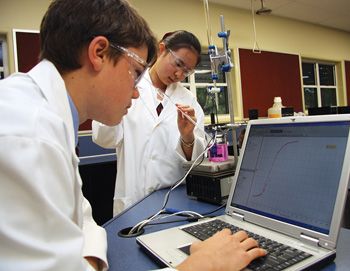A number of primary and high schools across Australia have adopted Australian sign language or Auslan as a language other than English, or LOTE option. Although many deaf communities use sign language not all deaf children are taught sign language as a matter of course. In fact, sign language is only one method of communication among others available to deaf people.
In 2017, the Australian Curriculum, Assessment, and Reporting Authority (ACARA) officially published the first national Auslan curriculum. Now formal study of Australian sign language is offered at schools across Australia. Currently, a national agreement sets out the formal study of Auslan in Years 11 and 12. There are calls for more states and territories to adopt the national curriculum, due to learners’ interest in Auslan as a subject that contributes to their ATAR or university entrance rank.
The national Auslan curriculum has two strands: an L1 first language learning pathway for deaf students to learn Auslan as native users, and an L2 second language learning pathway for hearing students. The curriculum systematises the provision of Auslan to both deaf and hearing students across Australia. It recognises the contribution of deaf communities and cultures to Australian society, and acknowledges their place within it.
This is a pivotal development for the Australian deaf community, because the teaching of Auslan within schools has been either non-existent, or inconsistent and often inadequately supported. In the past, where schools have offered Auslan instruction, it has been taught in informal lunchtime classes, or as an extracurricular activity outside class time rather than alongside other school subjects. Historically, the use of sign language has been discouraged or even prohibited in schools and other institutions, and deaf students were punished for using it. Such measures contributed to the oppression and marginalisation of deaf communities.
Traditionally, signing was frowned upon due to the misconception that it is a simplified form of communication, devoid of the depth of meaning and nuance found in spoken languages. Although Auslan and other sign languages have no written form, they have their own unique vocabulary and grammar. They can convey nuanced, technical, and complex meaning. Signing communities around the world have their own established traditions with regard to sign singing, theatre, poetry, storytelling, comedy, and jokes.
Benefits for School Communities
Learning Auslan benefits staff and students because it:
- Reinforces the development of neural pathways and cognitive processes in ways only a visual language can.
- Strengthens the memory and brain function of children.
- Improves visual-gestural communication skills which can be applied in International or cross-cultural settings.
- Allows hearing students to see deafness and disability in a positive light as “different”, and the acquisition of Auslan as a valuable tool for communicating with deaf people, particularly with deaf friends or family members.
- Accessibility for visual learners and other non-traditional learners including students with some forms of disability. The visual-gestural nature of sign language may appeal to children who have good kinaesthetic skills, and who find it easier to learn concepts and information when they are incorporated with physical movements.
- Offers opportunities for intellectual interest, engagement, and personal challenge.
- Offers opportunities for the integration of knowledge in other areas through the use of information and communication technologies.
- Facilitates the development of interpersonal skills, actions to wider social networks and diverse range of experiences.
- Increases understanding of notions of Deafhood, inclusivity, diversity, social justice, community membership, and cultural identity.
- Provides access to alternative ways of thinking and methods of communication.
- Strengthens overall literacy skills.
- Increases understanding of language systems, language learning, and learning processes.
- For deaf students and staff, Auslan in schools means greater access to the national curriculum as L1 language learners, and facilitates interaction with hearing students and staff who learn Auslan.
- Opens up career possibilities for hearing and deaf students as Auslan interpreters, teachers, notetakers, and carers for young Auslan users.
Issues to Consider with regard to the National Auslan Curriculum
However, several issues need to be considered to ensure that the implementation of the Auslan curriculum within schools is feasible and of maximum benefit to all involved.
Namely:
- The number of Auslan teachers, mentors, language models, members of the deaf community in a particular region. The provision and teaching of Auslan must be guided by members of the deaf community to ensure that students have opportunities to interact with native users, to create an authentic learning experience.
- The provision of L1 or L2 language learning programs would be an academic, emotional, social, and vocational advantage for deaf students.
- Excursions to deaf community events and relationships with members of deaf communities support the teaching and learning of Auslan, creating mutually beneficial connections between students and deaf communities.
- Auslan instruction is most effective if it is face-to-face. Teachers and students must have access to a variety of signed texts and signers. ICT School Resources bridge the gap for rural and remote learners, and those who would not otherwise have access to Auslan users.
- Addressing cross-cultural issues when teaching Auslan in Aboriginal and Torres Strait Islander communities. Auslan teachers should consult the local community about specific topics, relevant cultural considerations and local contexts to ensure that teaching and learning Auslan is a culturally sensitive process which respects and takes into consideration indigenous world views and sensibilities.
- The importance of promoting further research into Auslan, and the importance of developing, collecting and digitising quality teaching, reporting and assessment materials, and resources to ensure the best possible Auslan learning experience.
- Investment in the professional development of Auslan teachers to meet future interest and demand across Australian schools, and allowing Auslan users to lead the way in developing and implementing Auslan programmes.
- Deaf and hearing students need authentic opportunities to engage with each other. face-to-face or remotely via ICT. This allows hearing students to practice sign language in a real world setting. Deaf students have the opportunity to broaden their social network through such interaction. This increases communication between deaf and hearing staff and students in the school community.
Auslan instruction offers many benefits to staff and students in schools across Australia. To be successful, Auslan programmes must be underpinned by input and guidance from native users and deaf communities, and implemented in creative and thoughtful ways.
Sources
“Auslan: Developing teaching and learning.” Australian Curriculum. Australian Curriculum, Assessment and Reporting Authority.
“Auslan: Introduction.” Australian Curriculum. Australian Curriculum, Assessment and Reporting Authority.
“Auslan: Learning Auslan.”Australian Curriculum. Australian Curriculum, Assessment and Reporting Authority.
“Geographe Primary school’s language choice a sign of the times.” Busselton-Dunsborough Mail. 26 February, 2018.
“Students sign up to learn Auslan.” Department of Education. Government of Western Australia. 8 April, 2014.
Dalzell, Stephanie. “Auslan national curriculum hailed as ‘huge step’ for deaf community.” ABC News. 21 August, 2017.
Schembri, Adam. “Explainer: what is sign language?” The Conversation. 17 December, 2013.



